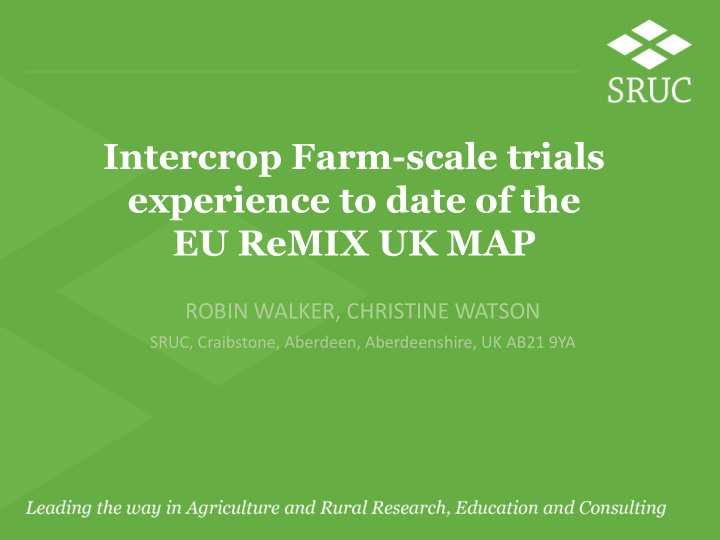



Intercrop Farm-scale trials experience to date of the EU ReMIX UK MAP ROBIN WALKER, CHRISTINE WATSON SRUC, Craibstone, Aberdeen, Aberdeenshire, UK AB21 9YA
ReMIX Objectives • Overcome barriers to stimulate the adoption of species mixtures by farmers and in agri-food chains Unravel mechanisms of plant-plant interactions to maximize resource use efficiency • Determine the role of species mixtures in controlling diseases, pests and weeds and • alleviating yield damages • Demonstrate the role of species mixtures in improving ecosystem service provision and development of resilience to biotic stress Identify key traits and create novel breeding and phenotyping methods. Generate novel • breeding material to grain legume / cereal mixtures • Develop generic rules for assembling species for efficient cash crop production using process- based simulation models Develop new management techniques to optimize species mixtures performance • Optimize settings and specifications for agricultural machinery for harvesting and • separating grains • Develop a toolbox, a serious game and technical booklets for farmers and advisors www.remix-intercrops.eu 2
ReMIX MAP Multi Actor Participation (MAP) – 11 “hubs” in 10 EU countries • “Hub” and satellite farm approach The UK MAP context: Current systems (generally): Input intensive, short term production • orientated, potential soil damage, increasingly erratic weather events Targets or new expectations: Reliable yields but using lower inputs, • especially cereals, seed potatoes and home grown protein production (grassland), improved soils - health & structure What are the main characteristics of the socioeconomic context?: Long- • term sustainability of business, soils and agricultural productivity Planned activities on the UK MAP: Interaction between farmers (online • discussion forum), MAP farm visits, open days / evenings 3
Approach @ “Hub site” Small plot trials based on known / suggested agronomy • Basic approach following from previous years RESAS trials – Discussion with farmer group (EU ReMIX) • Sowing rate treatment – in mixtures Yield / quality sampling regime • – Multi-use options aimed for • Biomass, Silage, Combinable grain – Feeding value • Analysis of micro-silage • Pulse use in animal feeding studies 4
Recruitment of farms & communication lines • ReMIX presented : by SRUC at several of their own and third party events (like this since May 2017) – E.g. demo at Cereals in Practice, Soil Association Innovative Farmers Field Labs, SOPA meetings, SRUC advisory service meetings • Follow up emails and phone exchanges with farmers & other interested parties (e.g. processor) – Conventional and organic - all have experience of intercropping – 2 farmers have intercrops on both organic and conventional land – closed Facebook Group - easier flow of information 5
Location of ReMIX MAP Farms 6
How are the farms involved? • How are crop mixtures chosen and who proposed them? – Farmer orientated with suggestions from other MAP participants • What are your questions on the crop mixtures? – Different for each farm (based around targeted end use) • Are they the same for each satellite farmers? – No, each farm chooses a crop mixture that fits in with their rotation and level of risk they are prepared to take, and which market is targeted • What knowledge is available? – Some research available from SRUC and wider afield including other farmers (√), alternative options for regional climate / soils (limited), herbicide options (limited), overcoming harvesting difficulties (limited) 7
Many intercrops in the MAP - currently all spring sown Central “Hub” Peas, beans, lupins, lentils - sole cropped (except lentil) and with spring • cereal – different ratios (60/40 & 40/60) tested Satellite farms (O = organic; C = conventional) (1) Beans & oats (O and C); Peas, OSR & oats (C); Barley & OSR (O); Barley, • strawberry clover, white clover, yellow trefoil (C). (2) Peas & barley (O & C) – with sole pea & barley crops • (3) Peas & wheat (O) • (4) Beans & OSR (C); Oats & clover (C); Lentils & flax (C) • (5) Pea & barley (O); Pea & wheat (O), Barley & wheat (O); Barley, wheat & • peas (O); Barley, wheat, peas & vetch (O) – with sole barley, wheat & pea crops (6) Oat, pea, vetch u/s high dual purpose grass mix, chicory & plantain; • Wheat, vetch, lupin (& volunteer quinoa); Oats, vetch u/s grass & white clover 8
EU-ReMIX UK MAP Closed Group - communication channels 9
Data sheets requested from farms • Time availability is a key resource so to keep things simple … – Basic semi quantitative information on crops either intercrops, or sole crop components (in adjacent stands) - • Germination (1-9 scale) • General stand (1-9 scale) • Yield estimate (t/ha) • Protein content (%) • Pest issue (1-9 scale) • Disease (1-9 scale) • Flowering time (1-9 scale) • Ripening (1-9 scale) • Lodging risk (1-9 scale) – Still awaiting data from farms who are pooling it together 10 10
Benchmark options 11 11
Peas - spring barley Pea sole cropped Pea-barley intercrop 12 12
Lupins - spring barley Lupin sole crop Lupin-pea intercrop 13 13
Beans - spring barley Faba bean sole crop Faba bean-barley intercrop 14 14
Lentils with spring oat scaffold Anicia Gotland 15 15
Thanks for your attention • Thanks to many colleagues CSS • and thanks to Scottish Government (RESAS) and EU ReMIX for financially supporting this work 16 16
Recommend
More recommend